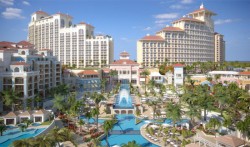As the earthquake and tsunami death toll in the Far East rose over 63,000 yesterday, the Bahamas was given a worrying reminder of what could happen if a volcano in the Canary Islands ever erupts and splits.
In fact, such a calamity could have an even greater impact than the current crisis in the Indian Ocean, where giant waves have taken more than 44,000 lives at the latest count.
For the waves created by a major eruption of Cumbre Vieja on La Palma could reach 330 feet high, devastating not only the west African coast, but also the eastern seaboard of the United States and the entire Caribbean region.
The Bahama islands, all of them low-lying, would take the full brunt of the mega-tsunamis and be completely swamped. The damage would be almost incalculable, both socially and economically.
Seismologist Stuart Sipkin stressed over the weekend that the Canary Islands tsunami scenario is the least likely of those that could occur in future. The Pacific is a much likelier location for a disaster of this kind because of the huge faults running through California and around the southern Alaskan coast.
Impact
But it can never be ruled out. And the Bahamas can learn from the devastating impact of the Sumatra earthquake by having an early warning system in place, and the means to get people off the beaches and out of harm´s way.
There is no doubt that the Sumatra tragedy, which has destroyed lives in countries all round the Indian Ocean, would have had less impact if even a rudimentary warning system had been in place.
As it turned out, thousands of people were actually on the beaches and in waterfront cafes when the waves crashed inland in countries like Thailand and Sri Lanka. Entire communities were simply washed away, and the complete death toll may never be known.
If Cumbre Vieja ever erupts and splits, with millions of tons of rock and earth plunging into the sea, the Bahamas and Florida will have roughly nine hours to brace themselves before the mega-tsunamis start to come ashore.
All the way across the Atlantic, the waves would gather a frightening momentum, moving at around 500mph and gaining height as they neared the coast.
As they drew close, water would be sucked from the shallow Bahamian beaches, exposing huge areas of seabed, leaving millions of fish to flounder in the sand and coral.
Then the water would crash inland with horrific power, washing away everything in its path.
In the Maldives, which took a hard hit from the Sumatra disaster, whole islands are said to have disappeared under massive walls of water. If Cumbre Vieja ever blows its top, the Bahamas, along with Haiti, the Dominican Republic and the entire Antilles chain, will take an even heavier hit.
However, the Bahamas, unlike many islands in the Caribbean basin, has no high ground on which people could take refuge. The best chance of escape would be to get into the highest and strongest buildings around, or fly out of the country during the limited time available before the waves hit.
Simon Day, of the Benfield Greig Hazard Research Centre at London University, said the Canary Islands volcano is not erupting at present. So the short-term and medium-term risks were “negligible’.
But he said Cumbre Vieja should be monitored closely for any signs of activity so that emergency services could plan an effective response.
“Eruptions of Cumbre Vieja occur at intervals of decades to a century or so and there may be a number of eruptions before its collapse,’ said Day.
“Although the year-to-year probability of a collapse is therefore low, the resulting tsunami would be a major disaster with indirect effects around the world.’
The problem with Cumbre Vieja is that it contains a deep, near vertical flawline which any future volcanic activity could expand into a chasm. Once this fissure widens significantly, it is in great danger of splitting the mountain in two, sending a massive volume of rock into the sea.
The energy released by such an occurrence would be equal to the electricity consumption of the entire United States during a six-month spell, according to scientists.
Collapse
The landslide itself would create a 3,000 feet high dome of water tens of miles wide. This would then collapse and rebound. In just ten minutes, the first tsunami would have moved 155 miles.
The west Saharan coast would be first to be hit, with 330-foot waves crashing ashore. Florida and the Caribbean, including the Bahamas, would have to brace themselves for 165-foot waves some eight or nine hours later.
Waves striking Europe would be smaller, but Spain, Portugal, Britain and France would all be affected. Without proper warnings, the death toll could be even higher than that of the current disaster in Asia.
A research study into the possibility of a Cumbre Vieja eruption warned that mega-tsunamis would push sea water many miles inland in the United States, causing trillions of dollars in damage.
The one encouraging factor for the Bahamas and the eastern US is that the Atlantic is much less susceptible to the tectonic plate activity that usually causes tsunamis. The Cumbre Vieja volcano is, however, potentially just as deadly as more conventional upheavals like quakes and tremors.
Tectonic
Bob Morton, research geologist at the US geological survey centre in St Petersburg, Florida, said the likelihood of tectonic activity in this area was very low – comparable, odds-wise, to an asteroid striking the state. The mid-Atlantic region is relatively benign with Cumbre Vieja one of the few potential flashpoints.
Robert Weisberg, professor of physical oceanography at the University of Florida, said tsunamis were born of undersea earthquakes, volcanic eruptions or submarine landslides.
“You get movement at the base of the ocean, which causes water to move,’ he said, “It´s like throwing a stone into a lake. Waves propagate away from the disturbance going very, very fast. From the epicentre to somebody´s beach takes a short period of time.’
In the Caribbean itself, the Puerto Rico Trench is a potential source of trouble, though this 27,000-feet deep undersea fissure has not produced a significant quake since 1946, when 1,800 people died in north-east Hispaniola.
In 1918, a tsunami killed 91 people in north-west Puerto Rico and in 1867 a 25-foot wave in the Virgin Islands killed five people. Since the 1940s, however, the Trench has been silent.
The closest thing to a Florida tsunami in recent memory was a rogue wave in Daytona 13 years ago.
The 18-foot monster injured 20 people and damaged 10 cars. It was later linked to thunderstorms from the Georgia coast.
As with most natural disasters, tsunamis offer few consolations, only powerful reminders that mankind is relatively helpless in the face of catastrophes which are beyond its control.
However, the Bahamas would do well in future to keep one ear cocked for news of Cumbre Vieja, the slumbering peak in the Canaries which clears its throat every decade or so.
If it ever erupts and blows skywards, with one side of the mountain falling into the sea, we know that trouble is on its way.
By John Marquis, The Tribune



